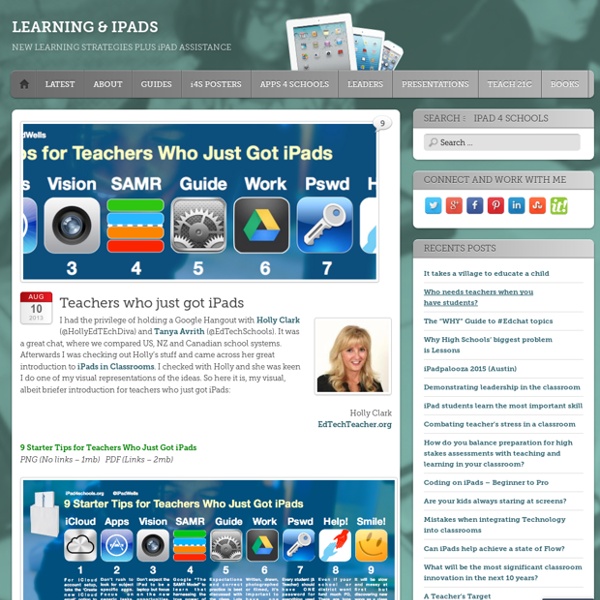Teachers who just got iPads
I had the privilege of holding a Google Hangout with Holly Clark (@HollyEdTEchDiva) and Tanya Avrith (@EdTechSchools). It was a great chat, where we compared US, NZ and Canadian school systems. Afterwards I was checking out Holly’s stuff and came across her great introduction to iPads in Classrooms. Holly ClarkEdTechTeacher.org 9 Starter Tips for Teachers Who Just Got iPadsPNG (No links – 1mb) PDF (Links – 2mb) Like this: Like Loading... Related 2 Teachers have 9 thoughts as iPad turns 5 I am very excited to be collaborating with the great Steve Lai again (@sly111). In "21C Learning" Analyzing iPad Myths in Education Are you still trying to fight for iPads in your school? iPads in schools! 20th Century pedagogy + iPads = Gaming So, you're in your classroom and annoyed that the kids are playing games on the iPads.
The 10 Most Popular Teacher Tools Being Used This Year
This image shows absolutely no teacher tools. Aside from that pencil maybe. But seriously, that says a lot about how far we’ve come! The school year is upon us. It’s quite literally the time for teachers, students, parents, school administrators, and everyone else to begin spending the vast majority of their day at a school. Whether it’s college, high school, middle school, or elementary levels, it’s school time. ‘Battle-tested’ might be a more appropriate term. In any case, these teacher tools are useful for a variety of reasons. 1.Google Apps Okay, this one is more than a single tool. 2. The king of PLNing (is that a word?) 3. I’ve been using Skype in education for years now and it’s proven to be an effective way to collaborate and communicate with others around the world. 4. What can’t you find on YouTube ? 5. Evernote is valued to be worth more than the New York Times. 6. Like Evernote, Dropbox lets you keep your digital life in sync. 7. 8. 9. 10.
23 iPad Alternatives to the Book Report.
EmailShare 1136EmailShare Upon hearing that they will have to read another book students usually roll their eyes and moan in disagreement. So to make the reading process more fun for them we let them chose their own book and their own creative assignment. There are three parts to the book report: A summary and personal opinionB character analysis,C creative assignment. Parts A and B are the same for everyone and resemble “traditional” book report assignments. Below you can see the list of assignments. For each of the assignments students will need to make sure that their piece of work shows that: They have read the bookThought deeply & reflected on the bookHave understood the assignment I have added all of the assignments to my iTunes U course that I am using this year. 1. 2. 3. 4. 5. 6. 7. 8. 9. 10. 11. 12. 13. 14. 15. 16. 17. 18. 19. 20. 21. 22. 23. Can you think of any other assignments? Related posts:
Your Perfect Solution For Sharing Student iPad Projects | teachingwithipad
There is an ever growing number of teachers and students using iPads for creation projects. Little by little, people are understanding that the iPad is not just a consumption device for reading emails, watching YouTube and checking FaceBook and Twitter. The iPad is a powerful creation device. But an issue arose during the year at my school: How does one share large student videos and other projects with parents? Read ahead to find out. Intro I have been using Copy quite heavily since I first reviewed about it six weeks ago. Download Copy here (free!) then refer your friends for an extra 5GB each (promotional period may end soon!) A colleague and I recently organized an iPad summer camp for students. Problem: Sharing the movies with parents at home As you may have experienced, sharing large files from iPads can be a daunting experience. We toyed with the possibility of sharing student work via YouTube, as its integration with iMovie makes it simple and pain-free to use. Dropbox? Conclusion
Related:
Related:



